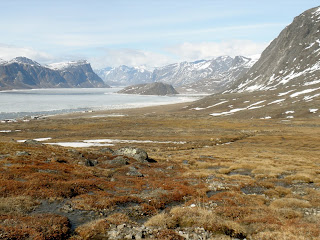
Unlike many Canadian Aboriginal communities, Pangnirtung has been able to preserve a great deal of their ancestral language. This may be in part due to their isolation from the South (the only way to reach Pang is by air or, for 3-4 months, by boat). For whatever reason--Inuktitut is the dominant language, regardless of age. I think that part of their strong cultural identity comes from this ownership of their language.
Pang has a vibrant Inuit culture that can be felt from the elders to the very young. The lines between extended families are blurred and front doors are left open. Elders in the community offer to make kamiks (seal-skin boots) asking nothing in return from total strangers. Kids share everything from sneakers to jawbreakers, an unspoken, unacknowledged trust between them.
Alas, Pang is not perfect, despite the great deal of cultural assuredness in many of the townspeople. A high school teacher pontificated that the youth were in a state of limbo between what the older generation defined as “the Inuit culture” and what the younger generation wanted --“southern culture”. Every year the youth are taken to the “Spring Camp” where they hunt, fish and live a traditional life for a month. Some of his students hated the experience and could not understand why they had to do it. The elders on the other hand wanted to give the youth the Inuit culture education that they were denied in residential schools.
Cultural continuity over time leads to a personal continuity over time. If your self-defined culture has a past, present and future then you are more likely to believe that you have a past, present and future. There is still a sickening suicide rate when compared to the rest of Canada. Vandalism and drug use have been cited by locals as major concerns and these issues keep getting worse. I met an awesome woman who was visiting from Greenland. She had been working there for over 10 years as an art/shop teacher. She talked about the same issues in her hometown. The fact is that Inuit on Greenland were forced to create communities about 100 years before Nunavut. This implies that the problem isn’t going to go away on its own. It’s not that the youth need to “get their feet under them”.
I'm still trying to see a way to bridge this gap between generations, to expand the undercurrent of culture beating through the community. You can’t force a culture on someone. But you can help youth to realize their own cultural intricacies and the elders to realize the need for development. Help them realize that their culture needs to develop around their interests, but also through the history and experience of elders. To do otherwise would be like trying to grow a culture in a day.




